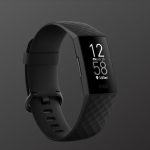Samsung Galaxy Fit e is another newly introduced wearable in the same price category. This fitness band boasts of a slim design and sports the essential features that you’d hope to find in such wearable devices. After all, the ‘e’ stands for Essential. We managed to get our hands on the Honor Band 4 and the Samsung Galaxy Fit e, and decided to pit both against each other to help you determine which is the better wearable for your needs. Let’s begin the comparison.
Design and Comfort
Let’s start with the design of the Honor Band 4. For a band in the sub-Rs 2,500 price range, the Honor Band 4 sports a beautiful sleek look. Its competitors have a tracking module in shape of a capsule that sits inside a silicone cavity. With Honor Band 4, the module sits flush with the band similar to watches. However, that doesn’t mean that you can’t use different straps to go with it. There are tiny silicone clips which you can remove easily if you want to try out straps in different colors. Another design feature that I love is its buckle. It sports a watch-style buckle which is easy to fasten. And all this is wrapped up by the use of comfortable and breathable silicone straps. During my experience with the Honor Band 4, I didn’t face any issues with sweat sticking between the bands and my wrist. And at the same time, the straps offers enough holes to adjust the fit for a better heart rate tracking. Compared to the Honor Band 4, the Galaxy Fit e is considerably sleek and slim. It comes with the conventional design where the capsule sits inside a silicon cavity, and you can pop it out when you want to change the strap. For a fitness band which costs north of Rs 2,000, I found the strap of the Fit e to be a tad flimsy, light, and the icky kind which sticks to your skin if you sweat too much. Plus, the clasp is a little out of the ordinary. That clasp comes in handy if you have to take the band on/off frequently. If you compare the material and the looks, they are insufficient compared to its competition.
Display and Sensors
Now, coming to the key feature of both the bands — Display. The Honor Band 4 packs a 0.95-inch AMOLED display. This touchscreen has a resolution of around 240×120 pixels, and the best part is that it is colored, and has a decent amount of contrast. So if you use a green watch face, it suits perfectly on a dark background. Other than that, the display is bright enough to be legible under harsh sunlight. However, it doesn’t have an ambient light sensor. So you will have to adjust the brightness from the settings. The screen is responsive, and swiping through the interface is a bliss. All you have to do is swipe up/down. If you look around, most of the bands at this price point comes with a black and white display (including the Xiaomi Mi Band 3) and the new Samsung Galaxy Fit e is no different. It has a 0.74-inch PMOLED monochrome screen, and the resolution is just 64 x 128 pixels. So if you take a close peek of the display, you can see the individual pixels. On the upside, you’ll be able to see everything clearly on the screen. Also, the combination of black and white does look classic. On the downside, the Fit e doesn’t employ a touchscreen display. So, instead of swiping, you’ll need to tap either on the screen. Hence, when it comes to user experience, navigating is not the smoothest in the Samsung Galaxy Fit e. A few times, I had to employ more than usual amount of taps (and force) required to wake up the screen or to navigate through the interface. While it may not bother you initially, it does get a tad annoying in the long run.
Features and Widgets
When it comes to the extra features, the Honor Band 4 has the following options — Watch Faces, Find Phone, Timer, Stop Watch, Brightness, and even restart the device. That is apart from the usual health-related features such as pedometer, sleep tracking, and heartbeat tracking. For now, you can switch between four faces. The colors are bright and vibrant. And since the touch gestures are fluid, starting the timer or stopwatch or even going through the notifications is quite a smooth affair. Sadly, the Galaxy Fit e doesn’t pack a plenty of extra features. You’ll get a heartbeat monitor, sleep tracker, a pedometer, amount of calories burnt, calendar information, and also weather forecast. And the good news is that if you are bored with the current watch face, you can switch between five more faces. The Honor Band 4 lets you switch the faces from the band itself. Meanwhile, Galaxy Fit e, requires you to take the aid of the Galaxy Wearable app. Of course, you can set alarms on both the trackers.
Battery Life
While talking about fitness band’s battery life, everyone wants it to run for days. And juicing it up shouldn’t take more than a couple of hours. Well, that’s what everyone expects. The 100 mAh battery of Honor Band 4 boasts a run time of 17 days under normal usage conditions. However, the charge can run out sooner when you have enabled key features like notifications and turned on the sleep tracker. In our case, the battery of the Band 4 lasted for around 8-10 days, with the sleep tracker turned on. Interestingly, the Galaxy Fit e contains a 70 mAh battery that can last about a week. However, enable all the features like messages, heartbeat sensor, and you can only expect it to last about four days. Also, the Galaxy Fit e makes you dependent on the Galaxy Wearable app if you want to see the remaining battery percentage. Also, if it is at 10%, it won’t vibrate neither will it send any notification. So, you’ll have to develop a habit, in the long run, to check for the remaining battery in the app.
Fitness Tracking: Accuracy
Now comes the most important part — how accurate are these trackers? Do they give you accurate stats or do you get just an estimate on your overall performance? Well, let us begin by stating what the Honor Band 4 and the Galaxy Fit e can track. For starters, both the fitness bands can monitor heartbeat, sleep, and workout sessions, apart from counting your daily steps. Both the bands can detect walking, running, and workouts automatically. However, you’ll have to dive in deeper into the workout scenes to track specific type of workouts. In short, you’ll have to command the bands manually. Other than that, these bands don’t have GPS chips, so they borrow the details off your phone to provide you the necessary stats like pace, maps, and speed. We rarely had the bands show us incorrect data. Of course, there’s a mismatch sometimes, but thankfully, the stats are not too off the mark to make them appear unbelievable. The Honor Band 4 tracks your sleep and divides your sleep data into three types — Deep sleep, Light sleep, and REM sleep, apart from the waking period. It tracks sleep even if you doze off during the day — most of the affordable trackers fail to do that. It’s worth noting that the Band 4 uses Huawei’s TruSleep algorithm for sleep tracking. As for the Galaxy Fit e, it can tell you how many hours you have slept, the quality of sleep (lightness and heaviness), and also how long you remained motionless. Yes, both the bands tell you pretty much all you need to know. But the thing about sleep tracking is that there’s no way to verify the data.
Verdict: Honor Band 4 or Samsung Galaxy Fit-e
So, which one should you pick? Well, the Samsung Galaxy Fit e has all the basic elements and features. When combined with Samsung Health, it lets you track a lot of activities. Yeah, it’s water resistant, has a decent battery life, and tracking abilities. But if you look at the band alone, it fails to impress. On the other hand, the Honor Band 4 checks all the right boxes. It has a good fit as well as a great display. Most of the features are accessible via the band itself so you aren’t dependent on the app unless you want to check the monitoring graphs. The above article may contain affiliate links which help support Guiding Tech. However, it does not affect our editorial integrity. The content remains unbiased and authentic.



















![]()



